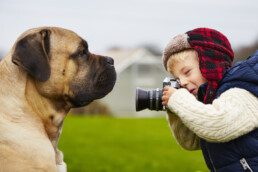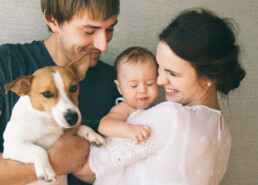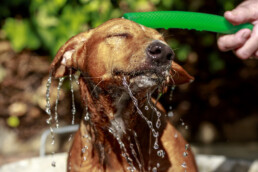How to take professional-looking pet portraits
We all like to photograph our pets and taking professional-looking portraits does not need to be as complicated as we think. Although it does take time and patience, it does not necessarily need a lot of expensive equipment.
Over the next few weeks, I'll be posting a series of lessons on how to photograph pets. Each one will look at a different aspect of pet photography. Here's an idea of what's to come:
Part 1: Photographic Equipment - selecting a camera; using auto and manual focus; lighting and accessories.
Part 2: Animal Behaviour - understanding animal behaviour; personal space/fear circle of pets; techniques to use and avoid during a photographic session.
Part 3: Natural Portraits - controlling natural light using fill-flash and reflectors.
Part 4: Studio Portraits - selecting suitable backgrounds; basic lighting set-ups; importance of eye contact.
Part 5: Action Portraits - photographing animals in motion; shutter speeds; background details.
Part 6: Digital Imaging Editing and Printing - basic image editing; printing your images.
I will also be posting some photographic exercises for you to try yourself.
The art of any form of portrait photography is to capture the character and personality of your subject. So you will need to encourage your pet to relax and behave naturally in front of the camera. Sessions should be kept short, because animals get bored quickly and once that happens you will have to put the camera away until another day. Also, as you cannot ask your pet to say 'cheese', you will have to resort to other ways and means to encourage them to 'smile' for the camera. But, above all, whatever approach you adopt when photographing your pet remember their safety and welfare must always come first.
The aim of this series is to give you, as a pet owner, the inspiration and knowledge to take stunning photographs of your pet, however inexperienced a photographer you are.
How to prepare your dog for a new baby
There’s so much to think about when you’re getting ready for a baby, but if you have a dog it’s worthwhile preparing early to ensure a safe and happy start to the relationship between your pet and your new baby.
Solve existing behavioural issues
Finding the time to do behavioural training might be difficult after baby comes, as you won’t want to be dealing with tough behaviour issues with your dog while also trying to look after a new baby. Behaviour that seems harmless now, such as your dog jumping up on you, may become dangerous if you are heavily pregnant or holding a brand new baby in your arms. If your dog has serious behaviour issues such as aggression, you may need to consult a professional dog behaviourist to help solve these issues before the arrival of your new baby.
Safe Walks
Ensure your dog walks well on a lead, without pulling, tugging you or lunging unexpectedly. This will make it easier for you to keep taking your dog out on walks if you have a pram to manage as well. So, why not try some practice walks with the pram before baby arrives, to help your dog get used to it.
Socialise
Begin socialising your dog with babies and young children, and rewarding it for any positive interactions with them. If your dog hasn’t been socialised with children much, you will need to be very cautious when you get started and keep your dog on a lead. You may also need to put a muzzle on your dog if necessary.
Baby Sounds
Desensitise your dog to baby noises beforehand so they are unfazed by the real thing when it comes along. Play recordings of babies crying, laughing and screaming to your dog on a regular basis at all times of the day. Start at a low volume, then increase the volume slowly in small increments only when your dog is acting calmly and not stressed. Reward your dog for calm behaviour while these sounds play.
Baby's sleeping space
It is important that you make the nursery off-limits to your dog. Through careful and consistent training, you should be able to condition your dog into understand this is a place they are not allowed go without you. Once your dog understands the rules, you can let them to enter the room. But, it is important to maintain enough control to send your dog out of the room when you need to. If you find it difficult to maintain this flexibility then it’s best to keep it fully off limits.
Introducing your dog to baby
To encourage a safe and peaceful introduction, try these tips:
- Have someone bring home something that smells of your baby (such as a wrap it has been wearing), so your dog can become familiar with the scent before meeting her.
- Help your dog relax by ensuring it’s taken for a long walk and has used up some energy before the introduction.
- On arriving home from hospital, greet your dog first before introducing the baby. Remember, your dog will have missed you and will be excited to see you, so doing this will help create a calm environment.
- Make sure your dog is calm before it is allowed to come near the baby. While holding your baby, gently call your dog over and allow it to sniff baby. If there is more than one dog in the household, do this with only one dog at a time.
- Reward your dog for its calm behaviour when meeting the baby. You should do this for their first few interactions to help build a positive association.
Warning signs
Learn to read your dog’s body language for any indication that it’s not happy or comfortable in a situation. If your dog growls, has its hackles raised or bares its teeth remove the child from the situation immediately. If your dog is stressed out or fearful, this is also a warning sign. Look for things such as panting, tense body language, the dog’s tail between its legs, trembling, or the dog trying to hide or escape a situation. Pay attention to these signs and remove the child if you ever see any of them.
Finally, it is important to remember that you must always supervise all interactions between a dog and a baby or young child. Even if your dog is extremely friendly and docile, babies and young children can do unexpected things and any dog can react in a negative way if it feels scared or threatened.
If your dog gives any indication that it is frightened of or aggressive to a child, immediately separate the two and consult a qualified animal behaviourist to help resolve any issues your dog may have with the situation.
How to protect your dog from heat stroke
As the warm summer weather approaches, it's important to remember that dogs are vulnerable to heat related injuries, the most dangerous of which is heat stroke, which can often prove fatal.
Heat stoke and heat exhaustion are dangerous conditions for any dog and should be avoided at all costs. Heat stroke occurs when the dog's normal body mechanisms are unable to keep body temperature within a safe range. A dog's normal body temperature is 100-102.5 degrees. A body temperature over 106 degrees is deadly.
Heat Exhaustion
Heat exhaustion, the early stages of heat stroke, occurs when the dog begins overheating. To remedy the effects of heat exhaustion, you must take immediate action to reduce the dog's body temperate and prevent the danger of heat stroke. Symptoms of heat exhaustion include diarrhea, nausea and vomiting, rapid panting, and the skin inside the ears reddening. Should you notice any of these symptoms and suspect your dog might be suffering from heat exhaustion, take immediate action by bringing your dog indoors to a cooler environment immediately, near a fan if you have one, offer some fresh water, and dampen the dampen the skin with lukewarm water and allow it to air-dry.
Heat Stroke
Signs of heat stroke include rapid panting, a bright red tongue, red or pale gums, and thick, sticky saliva. The dog may also show signs of weakness, dizziness and vomiting.
If you suspect your dog is suffering from heat stroke, remove them from the hot enviroment immediately. Wet them thoroughly with room-temperature water (do not use not ice or very cold water, as it will trigger other life-threatening conditions), and increase the flow of cool air around them with a fan.
Five Ways to Prevent Heat Stoke
So, here are five things to remember when the temperature gets high in the summer months:
- Don’t let your dog linger on hot surfaces like asphalt and cement. Being so close to the ground can heat their body quickly and can also lead to burns on sensitive paw pads. Keep walks to a minimum.
- Provide access to fresh water at all times. Make sure an outside dog has access to shade and plenty of cool water.
- Restrict exercise when temperatures soar, and do not muzzle the dog because it inhibits their ability to pant.
- Many dogs enjoy a swim, splashing in a pool, or running through a sprinkler in warmer weather can help bring body temperatures down.
- Never leave your pet in a parked car, not even if you park in the shade or plan to be gone for only a few minutes. The temperature inside of a car can reach oven-like temperatures in just minutes, often in excess of 140 degrees. That quick errand to the shops can very quickly turn into a disaster and could be fatal for your pet.
The last point is particularly important to remember. The number of times I have seen a dog left alone in a parked car at the supermarket during the warmer summer months is horrifying. If you know you have to stop by the supermarket to pick up a few groceries, please leave your dog at home. Your dog will thank you for it!
Remember: Any dog that cannot cool itself off is at risk from heat stroke!
Meet the dog lover behind Dublin's Cheeky Dog Bakery
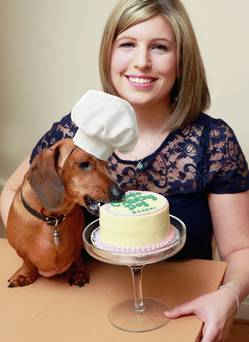
Recently at a DSPCA Doggie Day Out in St Enda's Park in Rathfarnham, Baxter and I came across a yummy new service just for dogs. Though we all know that cakes and sweets are not healthy for our dogs, it is great to see a new way of providing tasty treats for pooches.
Cheeky Dog Bakery began two years ago after dog lover Jenny McCarthy struggled to find a birthday cake to celebrate her dachshund Oscar's first birthday. Unable to find one, she decided to make her own. Much to Oscar's delight!
Inspired by her own attempt a baking a birthday cake for Oscar, she spent a year researching and testing recipes and acquiring all the necessary skills to set up her own dog bakery.
Jenny runs the successful Cheeky Dog Bakery online, selling everything from donuts to birthday cakes for dogs.
All her dog treats are hand made with dog friendly ingredients using only natural human grade organic ingredients, including carob, as dogs should never eat chocolate.

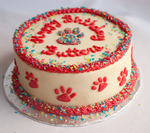
Jenny’s dog treats include a Birthday gift box, which contains a large two-tier cake cookie, a large Happy Birthday bone with paw and heart detail, two gift cookies with bow detail, 12 peanut butter Mini Bites and two delicious Puppermint Donuts in vanilla and carob - all for €20.
If you would like to order any cakes, have a special request or special doggy dietary requirements, Jenny can also tailor make special goodies with a little help from Oscar of course!
You can check out all her canine goodies at www.cheekydogbakery.com

